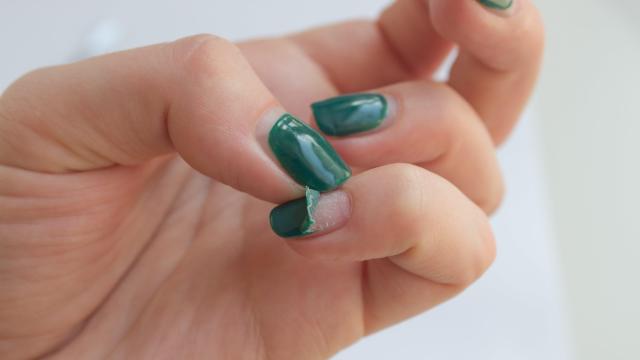There are no two ways about it: Gel nail polish is amazing. To be able to leave the salon with dry nails you don’t have to worry about accidentally smudging, denting, or uplifting altogether while the polish hardens, and then have colour strong enough to withstand multiple showers, countless dishes, and kid’s baths, and still look decent three weeks later is a miraculous relief for people who don’t have time to go to the salon every week.
But removing said miraculous polish — well, that’s another story. While it’s tempting to peel it all off with your teeth or the nearest coin over the course of one boring Zoom meeting, this method is not recommended, as it can take layers of your nail bed with it and lead to cracking. So what’s the best way to do it at home?
What you need to remove gel nail polish
The quickest, most effective way to remove gel is with 100% acetone polish remover (this is different from regular nail polish remover which is 90% acetone and 10% water). But you’ll need a few more supplies, too. Round up a nail file, cotton balls, aluminium foil or plastic wrap, an orange stick, and some sort of moisturizer (cuticle oil or thick hand cream). You’ll also want to protect your surface with plastic wrap and/or a towel, as acetone can damage furniture and counters.
Buff and protect each nail
With all methods, start with a thorough buffing of each nail with the file, to remove the top shiny layer of polish. Apply a generous amount of oil to each cuticle and the surrounding skin for protection (if you don’t have that, petroleum jelly also works). Next, decide your method of choice.
The nail-by-nail method
For this approach, first pull ten nail-sized portions of cotton ball and cut ten strips of aluminium foil or plastic wrap that will wrap fully around each finger. While aluminium foil will get the job done, the American Academy of Dermatology recommends using plastic wrap because “plastic creates a tighter seal than foil, so the acetone is less likely to drip.” The AAD also notes the importance of cotton balls no bigger than each nail surface (most nails require half a cotton ball, the pinky nail needs about a quarter of a ball) so they don’t coat the surrounding skin, which can lead to irritation.
Next, soak each cotton ball in the acetone. Place one piece of cotton over each nail, and cover with either small strips of aluminium foil or plastic wrap for a tighter seal. Remove after ten minutes. Any remaining polish should be peeling, and easily lifted with an orange stick or a warm wash cloth.
The “double boiler” soaking method
Alternatively, place a bowl of acetone over a bowl of hot or nearly boiling water and soak for 10 minutes. It’ll save you the hassle of wrapping each nail, but will render you immobile, as you’ll be required to keep your hand poised like a perfect eagle’s talon, with fingers bent and nails facing straight down.
This method arguably takes more remover, and it definitely promotes more acetone contact with your skin. Also, it can feel a little unpleasantly hot and smelly halfway through. The tops of my fingers felt like they had been doused in Krazy Glue after ten minutes, and the acetone was not targeted enough to work (my submersion skills apparently left something to be desired).
The natural method
Acetone is harsh and can strip skin of its natural oils, leaving it looking parched and white, so we tried a natural method. According to EverAfterGuide, soaking your nails in a bowl of warm water with a sprinkle of dish soap and teaspoon of salt will do the trick. They recommend soaking for 20 minutes. Well, we didn’t have 20 minutes, we had 10, after which time, the nail polish barely budged. Would it have if we’d left it in for the full suggested time? Maybe, but we prefer the speedier nail-by-nail acetone technique.
With any method, some gel base coat might remain. According to nail tech and salon owner Henry Pham of NailsFAQ, “adding some cuticle oil or cooking oil to the nails will loosen the small remaining gel base-coat spots so you can push them off easier.” And remember to moisturize because your nails have just been through it.

Leave a Reply
You must be logged in to post a comment.